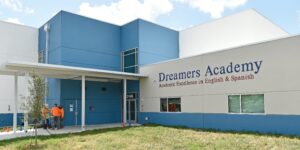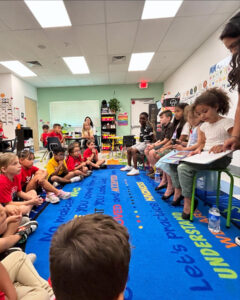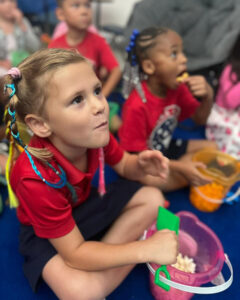Sarasota Schools’ strategic plan does not include expansion beyond one charter school.
By Johannes Werner
Original Air Date: June 5, 2024
Host: Yesterday, the Sarasota School Board unanimously passed a six-year strategic plan. Board members expressed enthusiasm, but many of the 39 public commenters used their three minutes to point out what they think is missing in the plan. One of the missing items is an expansion of dual-language immersion programs. Our news team has the details.
 Johannes Werner: The Dreamers Academy is a recent startup school in Sarasota. It offers the only bilingual immersion program in the region. But it’s a charter, rather than a public school, and that has critics saying that the school district fails to understand the need for, and the potential of these programs.
Johannes Werner: The Dreamers Academy is a recent startup school in Sarasota. It offers the only bilingual immersion program in the region. But it’s a charter, rather than a public school, and that has critics saying that the school district fails to understand the need for, and the potential of these programs.
Carol Lerner is the founder of an organization called Support Our Schools, and a frequent attender of Sarasota School Board meetings. She applauds the strategic plan as a good roadmap. But she is missing a stronger commitment to bilingual programs.
Carol Lerner: First of all, it is a charter school with a waiting list, so they can’t take in any more children. So that’s number one. Number two, there is such tremendous need. English language learners is one of the biggest demographics. The Latino population is over 20% of the school district. It’s the fastest growing demographic in the county. And the number of English language learners is very large. So we need multiple programs. And my view is that we need multiple programs within the district. Every study has shown that English language learners benefit tremendously. It encourages flexible thinking, the attention span improves because the child has to concentrate even harder when material is being presented in a different language. So it’s a win-win for everybody. Plus, it also gives young young people they’re bilingual, which is a wonderful asset for our economy, and in terms of careers.
JW: To be sure, the strategic plan does mention bilingual programs, providing for needs measurement. However, it seems the school district frames this as growth of the existing charter school. 
Another element missing in the strategic plans are community schools. This is a concept that turns particularly schools with disadvantaged students into hubs offering social services and full-day program providers. Carol Lerner:
CL: So we’re still hoping that with the community discussing it, that it will still happen at one point. My view is that every Title 1 school should have it. It actually would be a beneficial concept for every school, but definitely Title 1 schools. What the community school does, it provides all sorts of wraparound services to families, as well as enhance academic services to students, usually before and after school tutoring programs, all sorts of very interesting type of extracurricular activities.
JW: At the tail-end of the meeting, three board members addressed the elephant in the room: A radical new state voucher program that may end up draining funding from public schools. School board member Karen Rose expressed her full support for the voucher program.
Karen Rose: I want to make it very clear that I support our legislature. I support parents having a choice of where they send their child. For several years, more than 30% of our students couldn’t read at grade level. Who’s going to tell that parent that they don’t have an option? So I want to make it clear that I’m in agreement with our legislature. I applaud them for empowering parents to pick a school that matches their child’s needs.
 JW: Tom Edwards raised concern about a million-dollar gap opening up for the public schools in the district. He referred to a recent conversation with Bonnie Penner, the district’s chief financial officer.
JW: Tom Edwards raised concern about a million-dollar gap opening up for the public schools in the district. He referred to a recent conversation with Bonnie Penner, the district’s chief financial officer.
Tom Edwards: And we looked at about $10 million, give or take, that left the school district because of vouchers because of — I’m for choice, make no bones about it. But as those folks are leaving and the population that’s coming in are the ESE students that require more support, more headcount, more work, to be able to reach the academic goals that we all want. So it becomes a more costly school district with these voucher programs, and unless the public understands that, and unless Tallahassee understands that, we’re going to find ourselves in difficult situations financially. So as much as we all want choice, we have to make sure that we’re paying attention to the details.
JW: This has been Johannes Werner, reporting for WSLR News.
WSLR News aims to keep the local community informed with our 1/2 hour local news show, quarterly newspaper and social media feeds. The local news broadcast airs on Wednesdays and Fridays at 6pm.